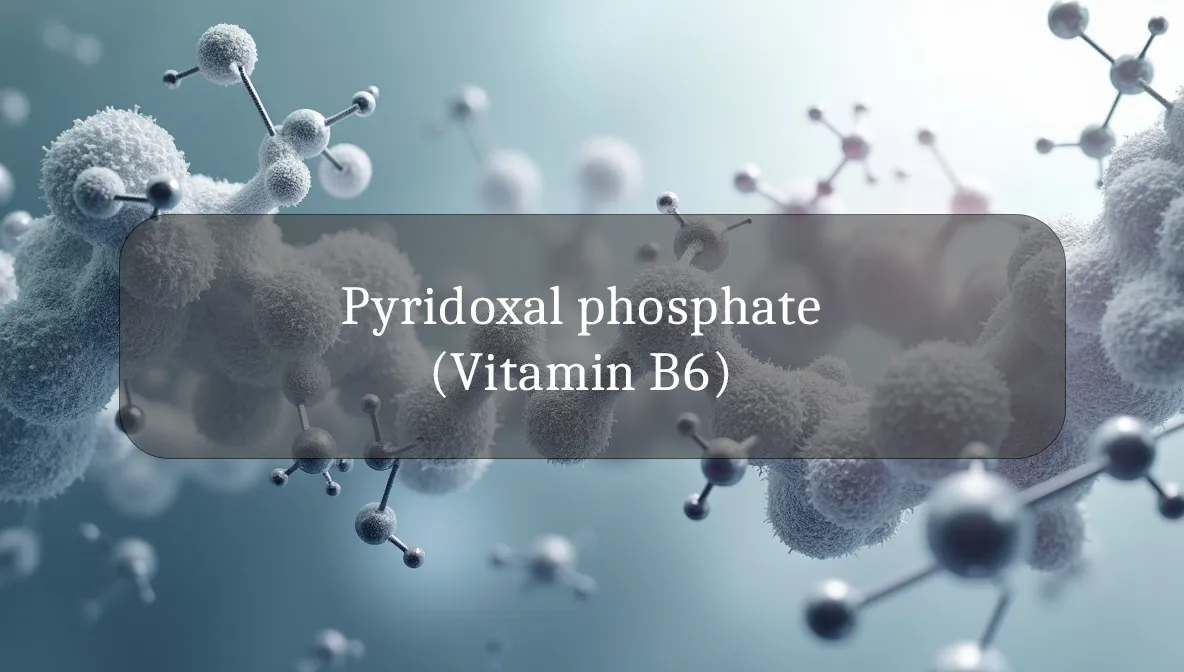Mood and Metabolism Booster
Pyridoxal phosphate (PLP), the active form of Vitamin B6, is like your body’s behind-the-scenes multitasker, supporting energy, mood, and overall wellness. This water-soluble vitamin is crucial for everything from brain health to red blood cell production. Let’s explore what PLP is, how it powers your health, and how to ensure you’re getting enough for daily vitality.
Chemical Identity and Type (Fat-/Water-Soluble)
Pyridoxal phosphate is the active coenzyme form of Vitamin B6, a water-soluble B-complex vitamin. This means it dissolves in water, isn’t stored in large amounts, and excess is excreted in urine, so you need regular intake. Chemically, PLP is derived from dietary forms of B6 (pyridoxine, pyridoxal, or pyridoxamine) and acts as a coenzyme in over 100 enzymatic reactions, aiding metabolism, neurotransmitter production, and more.
Biological Role and Health Benefits
PLP is a versatile nutrient that keeps your body and mind in top shape:
- Energy Metabolism: It helps convert carbs, fats, and proteins into energy, reducing fatigue and boosting stamina.
- Brain and Mood Health: PLP supports the production of neurotransmitters like serotonin (mood stabilizer) and dopamine (focus and reward), promoting mental clarity and emotional balance.
- Red Blood Cell Formation: It aids in making hemoglobin, which carries oxygen in blood, preventing anemia and supporting energy.
- Hormone Balance: PLP helps regulate hormones, easing symptoms like PMS or morning sickness in pregnancy.
- Immune Support: It supports immune cell production, helping your body fight infections.
By fueling energy, mood, and blood health, PLP keeps you feeling vibrant and focused.
Dietary Sources
Vitamin B6 is found in a variety of tasty foods, easily meeting your PLP needs:
- Meat and Poultry: Chicken, turkey, and pork (3 oz chicken breast: ~0.5 mg B6).
- Fish: Tuna, salmon, and cod (3 oz tuna: ~0.9 mg B6).
- Organ Meats: Beef liver (3 oz: ~1 mg B6).
- Starchy Vegetables: Potatoes and sweet potatoes (1 medium potato with skin: ~0.4 mg B6).
- Bananas: One medium banana provides ~0.4 mg B6.
- Legumes: Chickpeas and lentils (1 cup chickpeas: ~0.2 mg B6).
- Whole Grains: Oats and fortified cereals (1 cup fortified cereal: ~0.5–2 mg B6).
- Nuts and Seeds: Sunflower seeds (1 oz: ~0.4 mg B6).
- Supplements: B6 supplements (pyridoxine or PLP, 1.3–100 mg) or B-complex vitamins are available for specific needs.
A balanced diet with 1–2 B6-rich foods daily covers most needs.
Deficiency/Excess Signs
B6 deficiency is uncommon but can occur, while excess is possible with supplements:
- Deficiency Signs:
- Fatigue, weakness, or low energy.
- Irritability, depression, or confusion.
- Cracked lips, sore tongue, or skin rashes (seborrheic dermatitis).
- Tingling or numbness in hands/feet (neuropathy).
- Anemia (pale skin, shortness of breath).
- Excess Signs:
- High doses (above 100 mg daily, especially long-term) may cause nerve damage (tingling, numbness).
- Rarely, skin sensitivity to sunlight or digestive upset.
- Upper limit for adults: 100 mg/day from supplements/food.
If you notice deficiency symptoms or nerve issues, consult a doctor for blood tests or supplement guidance.
Recommended Intake and Supplementation
To keep PLP levels optimal:
- Recommended Intake: Adults need 1.3–2.0 mg B6 daily (men 19–50: 1.3 mg; men 51+: 1.7 mg; women 19–50: 1.3 mg; women 51+: 1.5 mg; pregnant: 1.9 mg; breastfeeding: 2.0 mg).
- Diet First: Include B6-rich foods like salmon, potatoes, or bananas daily.
- Supplements (If Needed):
- Low-dose B6 (5–25 mg) or B-complex for general health.
- Higher doses (25–100 mg) may be prescribed for PMS, nausea, or deficiency, but only under medical supervision.
- Effects may take weeks to resolve deficiency.
- At-Risk Groups: Vegetarians, older adults, or those with malabsorption (e.g., celiac, alcoholism) may need supplements.
- Timing: Take B6 with food to improve absorption and reduce stomach upset.
Always consult a doctor before high-dose supplements, especially long-term.
Safety, Interactions, and Precautions
B6 is safe at recommended levels, but caution is needed:
- Nerve Toxicity: Long-term high doses (above 100 mg/day) can cause irreversible nerve damage. Stick to the 100 mg upper limit.
- Medication Interactions: B6 may reduce the effectiveness of Parkinson’s drugs (e.g., levodopa) or interact with anticonvulsants (e.g., phenytoin). Discuss with your doctor if on these meds.
- Medical Conditions: If you have kidney disease or malabsorption disorders, consult a doctor before supplementing.
- Allergies: Rare allergic reactions (rash, swelling) can occur with supplements. Choose reputable brands tested for purity.
Fun Fact
Did you know pyridoxal phosphate is so versatile it’s involved in making the “happy chemical” serotonin from a simple amino acid? That’s why a B6-rich diet can give your mood a natural lift!
Citations
- National Institutes of Health (NIH): Vitamin B6 Fact Sheet for Health Professionals.
- Mayo Clinic: Vitamin B6 Benefits and Deficiency.
- Cleveland Clinic: B Vitamins for Energy and Mood.
- Journal of Nutrition: Pyridoxal Phosphate and Neurological Health (2020).
- Harvard T.H. Chan School of Public Health: The Nutrition Source – Vitamin B6.

